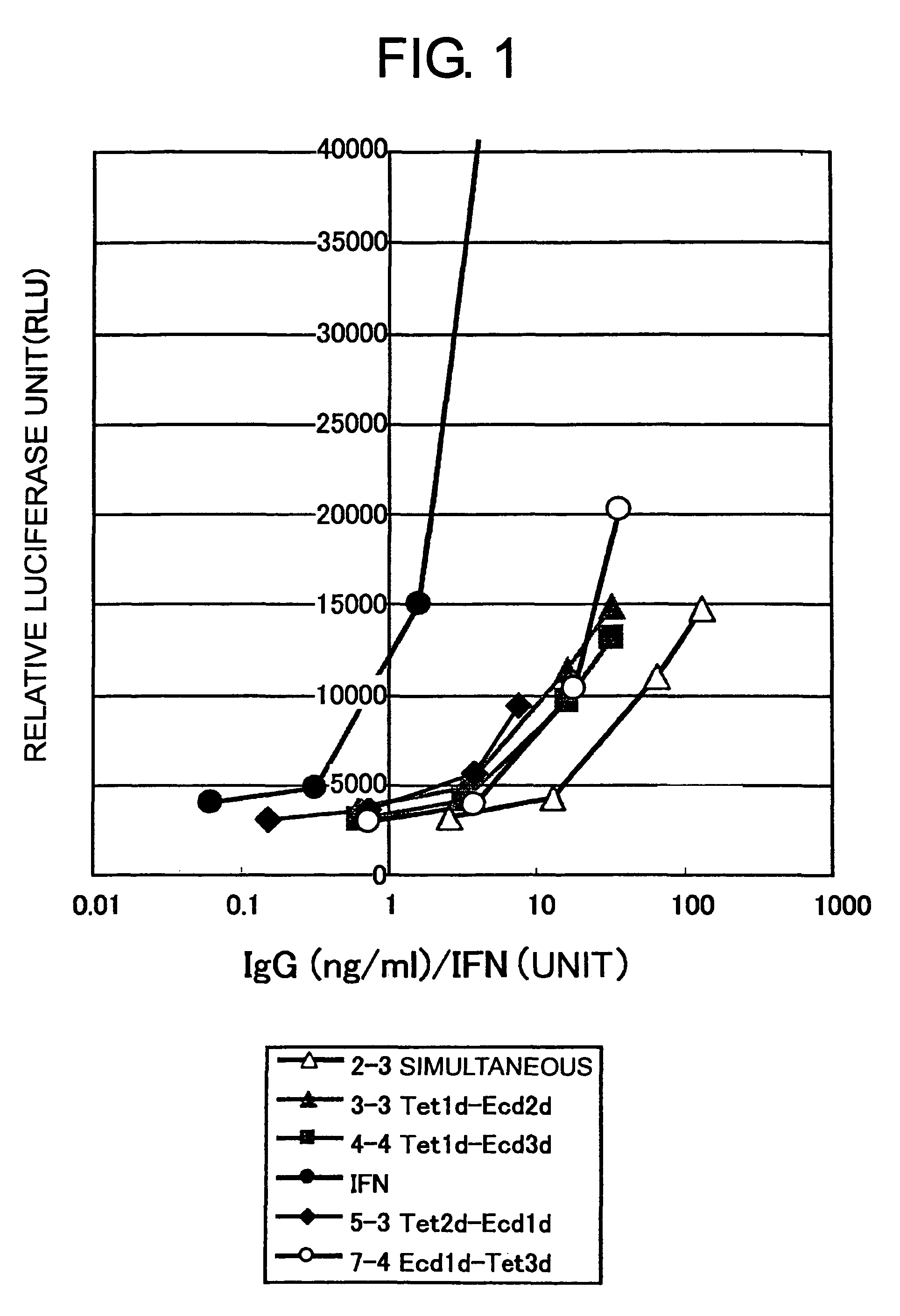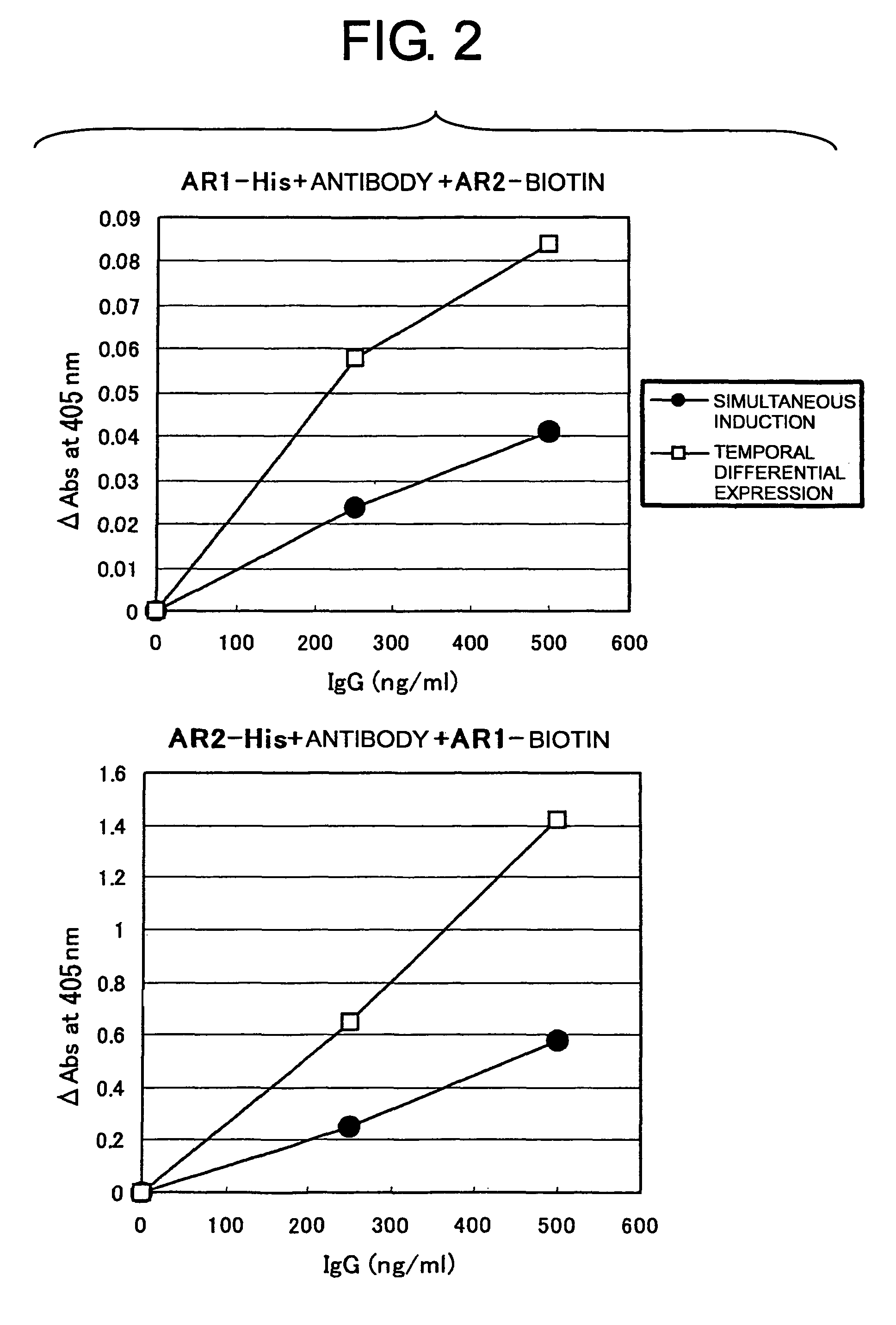Process for producing antibodies
a technology for producing antibodies and antibodies, applied in the field of producing antibodies, can solve the problems of not necessarily binding to the desired h chain, difficult to screen for antibodies, and inability to confirm the ratio of desired igg versus total igg produced, etc., and achieve the effect of increasing the specific activity of an antibody composition
- Summary
- Abstract
- Description
- Claims
- Application Information
AI Technical Summary
Benefits of technology
Problems solved by technology
Method used
Image
Examples
example 1
Construction of Expression Plasmids for a Bispecific IgG Antibody that can Bind to Human IFN Heteroreceptor (AR1 / AR2)
[0094]When only one of the light chains of an anti-AR1 or anti-AR2 antibody is expressed along with two H chains, and is shared by the H chains, the resulting antibody loses activity and may function as an inhibitor instead. Therefore, when both L chains are expressed and an IgG of a desired combination is preferentially expressed, the apparent specific activity of IgG is expected to increase.
[0095]When producing bispecific IgG antibodies, amino acids in the CH3 domain of human IgG4 were substituted based on the knob-into-hole techniques used for IgG1 (Ridway et al., Protein Eng. 9(61): 7-21 (1996)) so that molecules with a heterologous H chain combination were formed. The “type a” substitution product (human IgG4γa) carries Y349C and T366W substitutions, and “type b” (human IgG4γb) carries E356C, T366S, L368A, and Y407V substitutions. In addition, a substitution (-pp...
example 2
Preparation of Bispecific IgG Antibodies by Temporal Differential Expressions of HL Molecules in Animal Cells
2-1. Preparation of DNA
[0098]The expression vectors (pcDNA1-24H and pcDNA1-24L) for the right arm HL molecule of the antibody can be induced by tetracycline. In order to completely suppress their expression in the absence of tetracycline, the plasmid pcDNA6 / TR (Invitrogen) encoding the Tet repressor (TetR) is required. TetR forms a dimer, which binds to the two Tet operator sequences (TetO2) on pcDNA4 / TO and suppresses transcription of a desired gene. Once tetracycline is added, it binds to the TetR dimer and causes conformational changes, which release TetR from the Tet operator and then transcription of the desired gene is induced by the CMV / TetO2 promoter. On the other hand, the expression vectors (pIND2-7H and pIND2-7L) for the left arm HL molecule of the antibody can be induced by an analogue compound of the insect hormone ecdysone (muristerone A or ponasterone A). This ...
example 3
Measurement of Human IFN Agonist Activity by a Reporter Gene Assay
[0104]The IFN agonist activity (relative luciferase unit: RLU) of the non-purified antibody was examined using transformant cells that were a human hepatoma derived HuH-7 cell line (National Institute of Health Sciences, Japan) introduced with the plasmid pISRE-Luc (Stratagene), which carries the luciferase gene downstream of an element responsive to IFN stimulus. The activity was measured according to the instructions described in the manual accompanying the luciferase quantitation system Bright-Glo™ Luciferase Assay System (Promega). Human IFNα (rhIFN-αA, Calbiochem) was used as a positive control. The results are shown in FIG. 1. Samples with expressions induced using the inducible vectors at different times (3-3, 4-4, 5-3, and 7-4) had specific activities increased by 5- to 10-fold compared to samples with expression induced by the inducible vectors simultaneously (2-3). Thus, the results strongly suggest that exp...
PUM
| Property | Measurement | Unit |
|---|---|---|
| pH | aaaaa | aaaaa |
| concentration | aaaaa | aaaaa |
| concentration | aaaaa | aaaaa |
Abstract
Description
Claims
Application Information
 Login to View More
Login to View More - R&D
- Intellectual Property
- Life Sciences
- Materials
- Tech Scout
- Unparalleled Data Quality
- Higher Quality Content
- 60% Fewer Hallucinations
Browse by: Latest US Patents, China's latest patents, Technical Efficacy Thesaurus, Application Domain, Technology Topic, Popular Technical Reports.
© 2025 PatSnap. All rights reserved.Legal|Privacy policy|Modern Slavery Act Transparency Statement|Sitemap|About US| Contact US: help@patsnap.com


